As an Amazon Associate I earn from qualifying purchases.
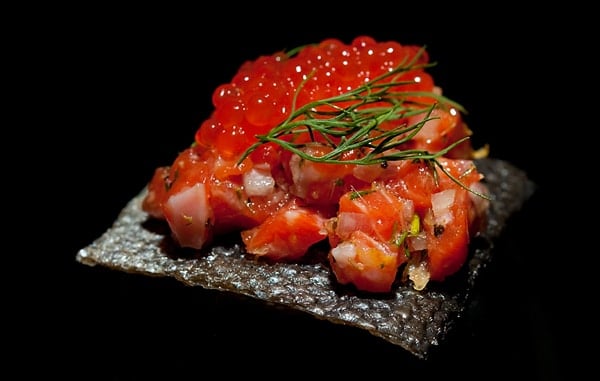
Tartare is, in many ways, the ultimate expression of fresh meat: To serve it says that this is clean and pure, that I am serving you raw meat — something that we humans have been a little leery of for hundreds of thousands of years — because I am assuring you that it is both tender and safe. Tartare is a gift.
Salmon tartare, however, is a gift with a wink. To be absolutely safe, you will need to freeze your salmon at -4°F or colder for a couple days and you are good to go; your home freezer is set at 0°F, so set it a little lower or leave the salmon in for more than 3 days. Otherwise you risk picking up the anisakis parasite, which will make you sick for a couple days.
OK, I’m done with horror stories about invasive parasites.
Sorry to have to go into that, but it really bothers me to see otherwise competent chefs laud how fresh their salmon is, when it is absolutely certain that at least some of the raw salmon they are serving will have these parasites. Their prejudice against freezing fish blinds them to the potential risk.
My version of salmon tartare is inspired by one my friend Dan Klein of the Perennial Plate made while we are all up in Cordova, Alaska fishing for Copper River salmon. We’d gathered some salmon berries that day, and he chopped them up with his tartare, topped with with fresh salmon caviar and served it on a salmon skin cracker.
I’d made crispy salmon skin before, but not the way Dan made it. The result, as you can see in the pictures, is a firm, very crispy cracker that is salmon-y without being fishy. It’s brilliant.
I also make quite a bit of salmon caviar at home, so I had some on hand. If you don’t, you can buy it at some fish markets, use some other caviar, or skip it.
Flavorwise, I wanted my tartare to go North, in honor of Alaska. Not having a lot of Alaskan ingredients on hand, I went Scandinavian instead. So I added a little horseradish, dill, and a new ingredient for me: A toasted pumpkinseed oil I got from Stony Brook Foods. Pumpkinseed oil is not actually a Scandinavian thing, it’s an Austrian thing; close enough for this recipe, I reckoned.
The oil is dark, viscous and looks a little like motor oil. But it has an intense roasted, nutty flavor that I can’t get enough of — it is every bit as wonderful as the finest olive oil. Added to this tartare, it immediately hits you with a sense of cool Northern Europe.
This is a party appetizer, something to impress your guests or loved one. It requires a little effort to make the salmon skin chips, but if you forgo them and use table water crackers (my second choice), this comes together in a snap. Just be sure to make more than you think you need: They will get eaten fast.
Salmon Tartare
Ingredients
- 1 pound salmon fillet, with skin if possible
- 1 shallot, minced, about 1/4 cup
- 1 to 2 tablespoons pumpkinseed oil or some other nice oil
- Zest of 1 lemon
- 1 tablespoon fresh chopped dill
- 1 teaspoon prepared horseradish
- 2 teaspoons dill pollen (optional)
- Salt and black pepper
- 1 tablespoon lemon juice
- 2 ounces salmon caviar
Instructions
- Slice the skin off the salmon with a fillet knife and gently scrape off any meat sticking to it. Pat the salmon skin dry with paper towels and lay flat, cut side down, on a non-stick skillet. Turn the heat to medium and place another flat, heavy surface on top of the skin. I use another pot. Let this cook for 5 to 8 minutes. Listen for it sizzling under the weight, and do not check the skin for at least 3 minutes -- this prevents it from curling up. Once the cut side looks crispy, turn the salmon skin, salt the side you just cooked, and repeat the process with the other side of the skin.
- When the salmon skin is crispy, take it out of the pan and let it cool for a minute or two. Use a sharp chef's knife to cut it into cracker pieces. Let it cool completely.
- Meanwhile, make the tartare by finely chopping the salmon into small dice. Do not put it into a food processor and do not shop it into mush. Put the chopped salmon into a bowl and mix in the shallot, pumpkinseed oil, lemon zest, dill, dill pollen if using, and horseradish. Salt and pepper it to taste and set it in the fridge to chill for up to a few hours.
- When you are ready to serve, mix the lemon juice into the tartare and scoop little piles of it on each salmon skin cracker. Top with a dollop of salmon caviar and serve. Have some table water crackers around to serve after the salmon skin crackers are eaten up.
Notes
Nutrition
Nutrition information is automatically calculated, so should only be used as an approximation.
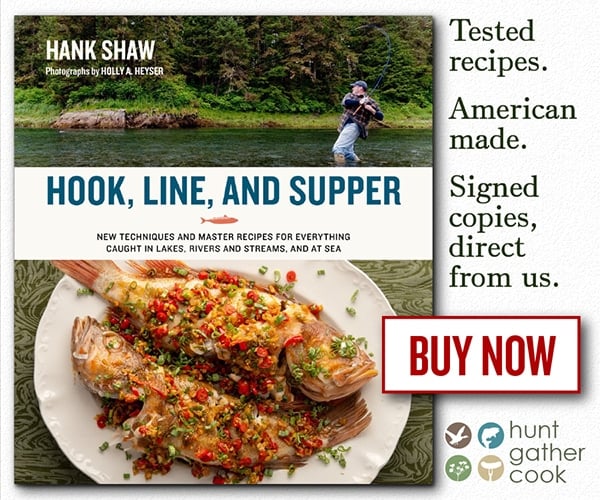
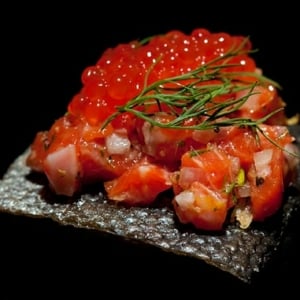

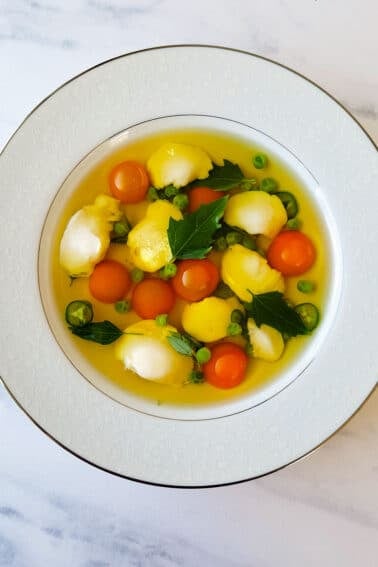
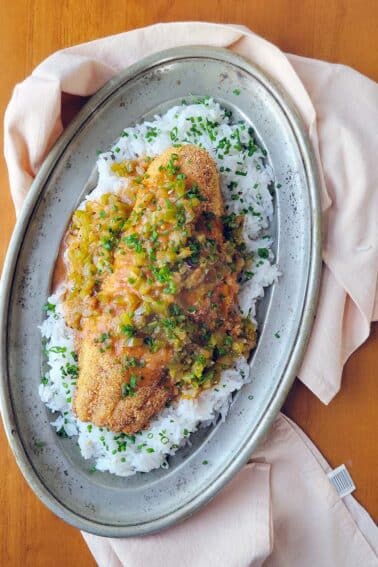

I plan on perfecting this recipe this summer!
Is there a risk of parasites or pathogens from freshly harvested salmon or trout roe?
Jonathon: I am not aware of people getting sick from freshly salted roe, but there is a slight chance of getting a parasite from unfrozen salmon meat. It’s rare, but it happens.
Absolutely beautiful! I grew up in the pacific Northwest, this reminds me of home!
Hank,
I stand corrected and thanks for the Caviar Recipe. Hope to use it very soon!
Guy
I have never actually taken the time to prepare any of the salmon I catch in raw form. I do eat it plenty of it raw but it is at the fish cleaning table. It started as a dare from a buddy of mine and has turned into a bit of tradition. I mix up a little dipping sauce (soy, honey, citrus) and set it on the table. After I have the sides of the fish of I scrap the meat off the bones. I crack open a beer and enjoy the spoils. You have inspired me to try something a little more high brow.
p.s. how is dove season going. Isaac blew a lot of my birds north and now its a waiting game.
Guy: You actually don’t need to scale the skin. I did not in this case, and they turned out fine. King salmon scales are very small. And as for the caviar, of course I made my own! Here is my caviar recipe.
Michal: Yep. You are good to go.
I know you apologised for talking about the practicality of parasites and fresh salmon, but I really didn’t know and am thankful for learning that information. It’s definitely something to take note of.
Beautiful photography as always. Salmon, in all it’s forms, is such a vibrantly camera-friendly fish and here your tartare just looks stunning!
If my only source of wild salmon is frozen am I basically good to go once it thaws?
Thanks!
Hank,
Great recipe! I have made a similar Tartar dish Polynesian style with fresh caught & then frozen Ahi tuna with Sesame Seed Oil, Coconut milk, ground ginger, Sliced Sweet Maui Onions, Cayenne pepper, and soy sauce to taste. Can’t wait to try this recipe. Two things that I thought were missed in the recipe, one is that scales need to be removed from the skin of the salmon before preparing the “cracker”, and two it would be nice if you gave the recipe for the salmon roe caviar, rather than store buy it. I catch female salmon on the American River every year laden with plenty of fresh roe, but unfortunately do not have a good recipe to cure the roe. My attempts have unfortunately been futile. When they are running good in October after we get some good rain I will be sure to drop you an invite, as this is your neck of the woods. Thanks as always for all the great recipes. I just got back from Mendota Wild Life Area where I was Dove hunting this Labor Day weekend. We did well and have my eye on trying your Prickly Pear BBQ Dove recipe. Thanks again.
Nice job with the chips. Where did you get such a cool idea?